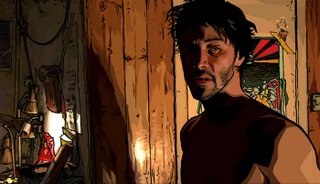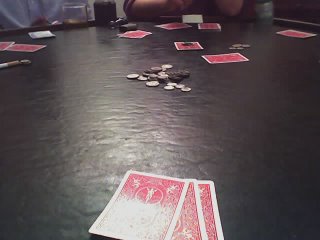Review: A Scanner Darkly

There goes a total dope fiend.
If your knowledge of A Scanner Darkly were limited to the contents of the film's trailer, you'd think it's a science fiction movie. You'd have no reason to think it's a movie about drug addiction, but that's exactly what it is. A Scanner Darkly isn't a sci-fi movie, or more accurately, it's a sci-fi movie only in the way that Gattica is a sci-fi movie. Though taking place in the future and relying on futuristic technology, ASD, like Gattica, never lets these elements become characters in the story. Rather, these elements act on the characters from outside the main focus of the story, which is concerned with the very human struggles of (relatively) ordinary people. Don't get me wrong--it's a great trailer, albeit a little misleading. An animated drug movie is a hard bird to take to market. An animated sci-fi movie based on a novel by Philip K. Dick is a little easier to wrap your head around.
 A Scanner Darkly tells the story of a cop and a criminal. "Fred" (Keanu Reeves) is the code name of an undercover narcotics agent who reports anonymously to the police, who are doing all they can to contain a near-future drug epidemic caused by a deadly new narcotic called Substance D. "Fred" reports to his superiors and performs all his official police functions while wearing a "scramble suit", a hi-tech full-body holographic covering that masks his identity both visually and aurally. Likewise, his superiors and fellow officers wear scramble suits, creating a double-blind method of law enforcement. Fred is undercover providing information on D addict Bob Arctor and his circle of D-head friends, two of which live with Arctor at his house. During a meeting with "Hank", his direct superior, Fred is told that they've received a tip that Bob Arctor has considerably more money than his meager day job can account for, and that he is to become the focus of Fred's investigation, which will now include 24-hour holographic scanning and recording of every room of Arctor's house. This presents Fred with a dilema he can't bring to Hank without breaching the code of anynomity, because Fred is Bob Arctor. And Bob Arctor is a Substance D addict and suspected dealer.
A Scanner Darkly tells the story of a cop and a criminal. "Fred" (Keanu Reeves) is the code name of an undercover narcotics agent who reports anonymously to the police, who are doing all they can to contain a near-future drug epidemic caused by a deadly new narcotic called Substance D. "Fred" reports to his superiors and performs all his official police functions while wearing a "scramble suit", a hi-tech full-body holographic covering that masks his identity both visually and aurally. Likewise, his superiors and fellow officers wear scramble suits, creating a double-blind method of law enforcement. Fred is undercover providing information on D addict Bob Arctor and his circle of D-head friends, two of which live with Arctor at his house. During a meeting with "Hank", his direct superior, Fred is told that they've received a tip that Bob Arctor has considerably more money than his meager day job can account for, and that he is to become the focus of Fred's investigation, which will now include 24-hour holographic scanning and recording of every room of Arctor's house. This presents Fred with a dilema he can't bring to Hank without breaching the code of anynomity, because Fred is Bob Arctor. And Bob Arctor is a Substance D addict and suspected dealer.The two halves of my brain...are competing?
To make matters even worse for Fred/Arctor, there's the very nature of Substance D itself. Highly addictive and new enough for the long-term effects to be largely unknown, it's a ride nobody ends on their own, not without a stint in a neural aphasia clinic. "There are no 'weekend warriors' on the D," Arctor's friend and roommate Jim Barris muses. "You're either on it...or you haven't tried it." What is known about D is that it causes serious brain damage, not only to the hemispheres of the brain, but to the connecting tissue that passes signals between them. Each hemisphere senses the damaged areas of the other and attempts to compensate, while the other hemisphere is unaware of the compensation, effectively splitting the addict's brain into two entites vying for control. The more Bob Arctor abuses Substance D, the less aware he is that he is also Fred, and the less Fred is aware that he is also Arctor. Soon the concept that he is narcing on himself is totally beyond his grasp.
How many caps do you take per day?
 Bob Arctor's world is populated by drug addicts, and it's through these characters that A Scanner Darkly's sense of humor shines. This is a funny movie for one that looks at its grim subject matter so seriously. Jim Barris (a perfectly cast Robert Downey Jr.) is a smug fast-talking intellectual with a conspiracy theory for every occasion and a fondness for projects that never quite work (how to make a silencer out of toilet paper rolls, how to extract a pure gram of cocaine from items available at the corner store for less than $3). Ernie Luckman (Woody Harrelson) is an intense and imposing clown who'd be frightening if he were a little more serious. Charles Freck (Rory born-on-a-green-light-daddy-o Cochrane) is a twitching paranoid wreck whose D addiction has progressed to full-blown halucination. Freck opens the movie, believing himself to be covered with bugs. After several showers and a dousing with insecticide he phones Barris to gripe. "They're aphids; I looked 'em up. They're everywhere--in my hair, on my skin, in my lungs. And the pain, Barris...it's unreasonable!"
Bob Arctor's world is populated by drug addicts, and it's through these characters that A Scanner Darkly's sense of humor shines. This is a funny movie for one that looks at its grim subject matter so seriously. Jim Barris (a perfectly cast Robert Downey Jr.) is a smug fast-talking intellectual with a conspiracy theory for every occasion and a fondness for projects that never quite work (how to make a silencer out of toilet paper rolls, how to extract a pure gram of cocaine from items available at the corner store for less than $3). Ernie Luckman (Woody Harrelson) is an intense and imposing clown who'd be frightening if he were a little more serious. Charles Freck (Rory born-on-a-green-light-daddy-o Cochrane) is a twitching paranoid wreck whose D addiction has progressed to full-blown halucination. Freck opens the movie, believing himself to be covered with bugs. After several showers and a dousing with insecticide he phones Barris to gripe. "They're aphids; I looked 'em up. They're everywhere--in my hair, on my skin, in my lungs. And the pain, Barris...it's unreasonable!" Above them all is Donna Hawthorne (Wynona Rider), Bob Arctor's almost girlfriend. Fred is using her as part of his investigation, buying larger and larger quantities of D from Donna until she can't front the money for his purchases and must refer him up the ladder. Bob is ernestly, achingly in love with her. Though emotionally approachable, Donna shies away from any form of physical intimacy, and the frustration of this unrealized romance fuels Arctor's confusion and drug use. Her power extends even to the author: the sympathetic yet unattainable brown-haired girl is a recurrent figure in Philip K. Dick's writing.
Above them all is Donna Hawthorne (Wynona Rider), Bob Arctor's almost girlfriend. Fred is using her as part of his investigation, buying larger and larger quantities of D from Donna until she can't front the money for his purchases and must refer him up the ladder. Bob is ernestly, achingly in love with her. Though emotionally approachable, Donna shies away from any form of physical intimacy, and the frustration of this unrealized romance fuels Arctor's confusion and drug use. Her power extends even to the author: the sympathetic yet unattainable brown-haired girl is a recurrent figure in Philip K. Dick's writing.What does a scanner see? Into the head? Into the heart?
Other recurring themes in Dick's writing that are on display in ASD are schizophrenia (though never diagnosed, Dick often wondered that he might be schizophrenic) and the phantom twin. (Dick's twin sister died just days after their birth. He is now buried next to her.) The two opposing characters of Arctor's consciousness are only partly aware of each other and unable to understand they are the same person. Lapsing into depression, the brain damaged Arctor hopes that Fred will be able to help him by studying the holographic recordings of the scanners that blanket his house, hoping the inhuman surveillance devices will offer up some insight he's incapable of himself. Keanu Reeves may not be considered the most flexible actor of his generation, but this is a role he is perfect for. He is able to convincingly show us all sides of Bob Arctor--spacey jovial head, dedicated cop, doting boyfriend, and powerless addict. The part calls for a high degree of numbness, and Reeves carries it off without seeming like he's fishing for an Oscar or rehashing Ted Theodore Logan.
That sure is some silencer!

 Deserving at least as much praise as Reeves is the supporting cast. Woody Harrelson and Rory Cochrane both could've overacted shamelessly in what are essentially two comic relief druggie roles, but here they display subtlety and deft comic timing that perfectly sells the sly humor of the book. Wynona Ryder has a more complex task in Donna Hawthorne, a woman torn in many opposing directions. Called upon to present a broader emotional range than any other cast member, she delivers across the board. She also makes a hell of an argument for rotoscope porn. As Jim Barris, Robert Downey Jr. is on like only he can be. Barris is a paranoid, fast-talking techie; through him Downey is able to spout off a practically endless stream of funny lines, and there's a knife behind every single one of them. He does a great job of portraying the kind of guy nobody really likes, even the people in his social group, and he's consistently funny while doing it. Not too shabby.
Deserving at least as much praise as Reeves is the supporting cast. Woody Harrelson and Rory Cochrane both could've overacted shamelessly in what are essentially two comic relief druggie roles, but here they display subtlety and deft comic timing that perfectly sells the sly humor of the book. Wynona Ryder has a more complex task in Donna Hawthorne, a woman torn in many opposing directions. Called upon to present a broader emotional range than any other cast member, she delivers across the board. She also makes a hell of an argument for rotoscope porn. As Jim Barris, Robert Downey Jr. is on like only he can be. Barris is a paranoid, fast-talking techie; through him Downey is able to spout off a practically endless stream of funny lines, and there's a knife behind every single one of them. He does a great job of portraying the kind of guy nobody really likes, even the people in his social group, and he's consistently funny while doing it. Not too shabby. The majority of A Scanner Darkly's press focused on its look, and with good reason. Director Richard Linklater, who also adapted the novel for the screen, used an animation technique called "rotoscoping", which he also utilized on his previous film, Waking Life. With rotoscoping, live actors are shot with digital video cameras, then the live footage is "painted" over. The result is something that straddles the line between live action and cartoon, and the look fits the subject matter and tone of the movie perfectly. It creates a realistically detailed unreality that reflects the mindset of the drug-addled characters. As unique as the visuals are, after a few minutes of viewing you stop gawking at them and focus on the plot and characters, which is a testament to the strength of the film behind the animation.
The majority of A Scanner Darkly's press focused on its look, and with good reason. Director Richard Linklater, who also adapted the novel for the screen, used an animation technique called "rotoscoping", which he also utilized on his previous film, Waking Life. With rotoscoping, live actors are shot with digital video cameras, then the live footage is "painted" over. The result is something that straddles the line between live action and cartoon, and the look fits the subject matter and tone of the movie perfectly. It creates a realistically detailed unreality that reflects the mindset of the drug-addled characters. As unique as the visuals are, after a few minutes of viewing you stop gawking at them and focus on the plot and characters, which is a testament to the strength of the film behind the animation.Fans of Dick's novel will appreciate that Richard Linklater has crafted a very faithful adaptation. Still, there are a few changes that those familiar with the book will find somewhat jarring. The character of Jerry Fabin is gone, his actions being performed in the movie by Charles Freck. (In the book Fabin has the bug problem, not Freck.) In the movie we learn within the first 20 minutes that Substance D has an organic componnent, while in the book this is a Big Reveal saved for near the end. The movie also discloses the identity of the tipster informing against Arctor very early, which was another Big Reveal in the novel. I was surprised to find that these changes didn't negatively affect the movie. I suspect the changes to the two Big Reveals were done to keep the ending of the movie more focused on Arctor.
What do you think about the New-Path?
 A Scanner Darkly was a highly autobiographical novel for Philip K. Dick. After his fourth marriage fell apart in 1970 he abandoned writing and lived communally with a rotating group of young drug addicts for two years. It was during this time that Dick's well-known amphetamine use reached its peak. In the novel's moving afterward, Dick likens drug abuse to a group of children playing in the street; every day they watch as more and more of their friends are cut down by traffic, but they still keep playing. Dick believed these people were punished far too harshly for their quest for a good time. A list of casualties, himself among them, immortalizes his friends lost or permanently damaged by the experience. "They remain in my mind, and the enemy will never be forgiven," he wrote. "The 'enemy' was their mistake in playing. Let them all play again, in some other way, and let them be happy."
A Scanner Darkly was a highly autobiographical novel for Philip K. Dick. After his fourth marriage fell apart in 1970 he abandoned writing and lived communally with a rotating group of young drug addicts for two years. It was during this time that Dick's well-known amphetamine use reached its peak. In the novel's moving afterward, Dick likens drug abuse to a group of children playing in the street; every day they watch as more and more of their friends are cut down by traffic, but they still keep playing. Dick believed these people were punished far too harshly for their quest for a good time. A list of casualties, himself among them, immortalizes his friends lost or permanently damaged by the experience. "They remain in my mind, and the enemy will never be forgiven," he wrote. "The 'enemy' was their mistake in playing. Let them all play again, in some other way, and let them be happy." Philip K. Dick wrote A Scanner Darkly to illustrate the consequences of serious drug abuse, and Richard Linklater's film remains devestatingly true to that end. It's an enjoyable and entertaining movie, but one with a heavy cloak of sadness. The tagline reads, "Everything is not going to be OK," and that's very true. For all its humor, ASD is not an upbeat movie. Does it leave hope for the future? Yes, but that hope comes at a terrible cost. A Scanner Darkly raises questions about the consequences of our actions, the nature of identity, the ethics of the war on drugs, the commercialization of the medical industry, and the use/abuse of surveilance techniques by law enforcement. Rather than preach a message to its audience, it invites its viewers to ponder these issues for themselves. It's a film that will weigh heavily on your thoughts after you watch it, making you an active participant rather than a popcorn-chewing observer. It's a serious film for serious consideration. If that sounds like what you're looking for, I can't recommend it highly enough.
Philip K. Dick wrote A Scanner Darkly to illustrate the consequences of serious drug abuse, and Richard Linklater's film remains devestatingly true to that end. It's an enjoyable and entertaining movie, but one with a heavy cloak of sadness. The tagline reads, "Everything is not going to be OK," and that's very true. For all its humor, ASD is not an upbeat movie. Does it leave hope for the future? Yes, but that hope comes at a terrible cost. A Scanner Darkly raises questions about the consequences of our actions, the nature of identity, the ethics of the war on drugs, the commercialization of the medical industry, and the use/abuse of surveilance techniques by law enforcement. Rather than preach a message to its audience, it invites its viewers to ponder these issues for themselves. It's a film that will weigh heavily on your thoughts after you watch it, making you an active participant rather than a popcorn-chewing observer. It's a serious film for serious consideration. If that sounds like what you're looking for, I can't recommend it highly enough.I'm writing this review too late for you to seek out ASD in the theater, and this is the first time on this blog that I honestly apologize for the lateness of a post. You'll now have to wait for the DVD, which at the time of this writing doesn't yet have a release date, but I'm betting it'll show up sooner rather than later. While you're waiting there are two things I encourage you to do. First, read the book. Second, go to Rotten Tomatoes, who are hosting a hi-quality streaming clip of the first 24 minutes of A Scanner Darkly. It's a great way to preview the film. How many times have you seen that episode of Drew Carey that just started? Turn it off and watch the first 24 minutes of ASD instead. Do it. Trust me.







